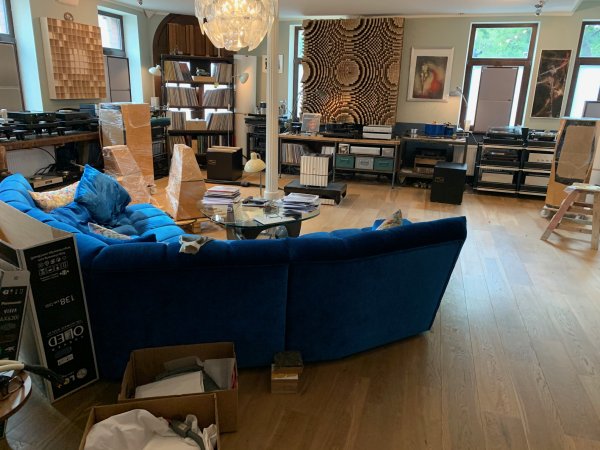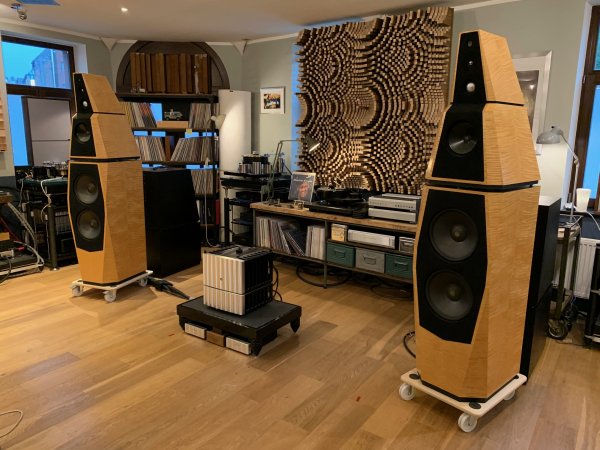I am interested into Avalon Acoustics speaker since decades,
so I tried to research the history of Avalon Acoustics on the web, should someone has better or more detailed knowledge, I am of course happy about additions and corrections.
Avalon Acoustics speakers have been around since the 1980s and have a varied history. The Avalon Acoustics company was founded by Charles Hansen, who already relied on the work of the development engineer Neil Patel since foundation of the company.
The first speakers presented already had the typical housing design that is still valid today.
This design should not only optimize the sound radiation of the speakers, but also help to disperse the reflections of the bounding room walls.
The first models were given the names "Avatar", "Eclipse" and "Monitor", especially the Eclipse became a commercial success. As the last model of the first portfolio, the top model "Ascent" was presented, which should have been the technology carrier of the Avalon company for many years. The "Ascent" uncompromisingly implemented what Neil Patel had imagined at the time. It didn't make the "Ascent" easier to sell, but it was important to Neil Patel that the crossover in his top model had to be housed in a separate housing.
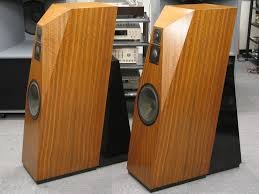
(The crossover in the separate black housing behind the speakers)
The Avalon Ascent is (in my view) one of the rare offers in the used market,
where you get a very high sonic equivalent to the current market price.
The speakers from Neil Patel and Charles Hansen required a certain level of performance from the connected amplifiers right from the start. The elaborate crossovers simply consumed power, so that the efficiency of the entire portfolio remained below 90db. The impedance curves, on the other hand, were amplifier-friendly, so that Avalon speakers can also be seen with powerful tubes from Audio Research, for example. (in my personal opinion, the bass drivers ever needed some damping factor, so I am not a friend of tubes or Pass / Krell amps on Avalon speakers)
Shortly after the Avalon Ascent appeared, Charles Hansen founded a company for high-end electronics (the Ayre company) and sold the company Avalon Acoustics to Jeff Rowland, who also hired Neil Patel as head of development.
Thanks to Jeff Rowland's contacts, the young company Avalon Acoustics found many new distributors, especially in Asia. Even today, many companies offer Avalon Acoustics speakers and Jeff Rowland amplifiers together.
Unfortunately, the market reacted very negatively to the acquisition of Jeff Rowlands. Previously, many loudspeaker manufacturers had advertised Jeff Rowland's amplifiers as the ideal partner for their own products, but now Jeff Rowland was taken as a competitor and his devices were not longer supported / shown on fairs.
So Jeff Rowland decided to sell Avalon Acoustics to Neil Patel in 1989, who has run the company since then.
Neil Patel carefully renewed the Avalon portfolio and created the probably successful Avalon Acoustics loudspeaker, the Avalon "Eidolon" in the early / mid-nineties.
The program was rounded off by the Avalon "Artus".
The last model offered in 1996 was the one offered until 2005
Avalon Acoustics "Osiris"
presented.
All three models were then marketed by Neil Patel / the Distributors as "The New Avalon"
I found as an example a Japanese brochure :
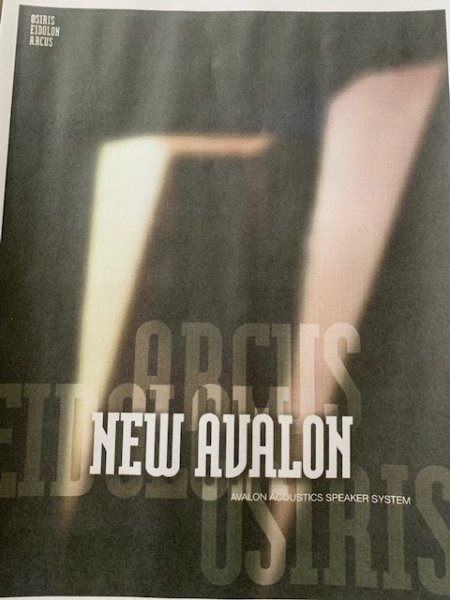
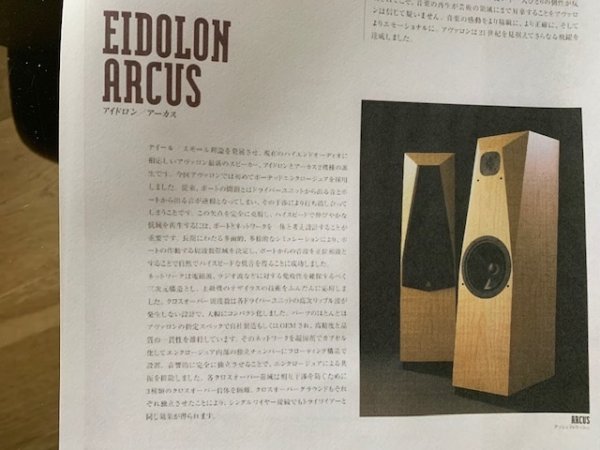
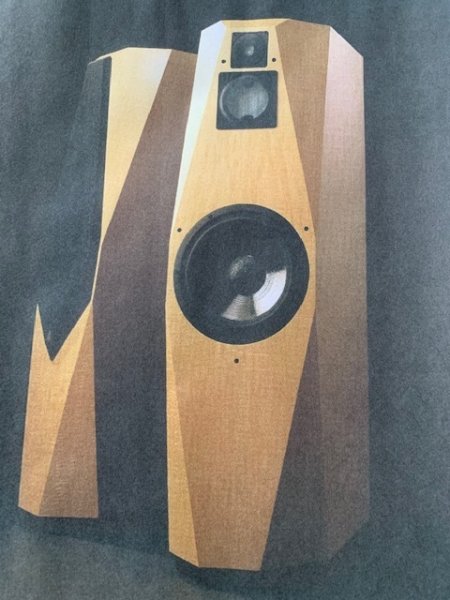
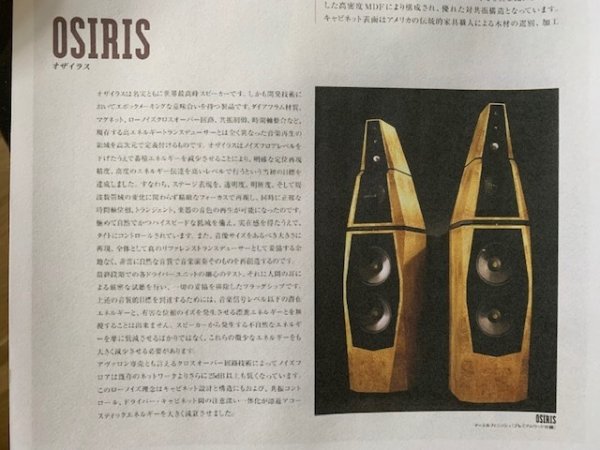
The Avalon Osiris was offered in Germany in 1996 with a MSRP of 160,000 DM, in 2005 the speaker had risen to about 125,000 EUR. The successor Avalon Sentinel was offered from 2005 at 180,000 euros, currently the Avalon Tesseract presented in 2015 is currently the top model with 350,000 to 400,000 euros in the respective price lists.
Avalon Acoustics was also obviously unable to escape the global price trend in the high-end market
I suspect this will not be the last step
The top models from Wilson Audio (Chronosonic) and Magico (M9) already reach the 750,000 euro threshold, so some headroom for the next Avalon Acoustics Top Model.
If you take a closer look at the Avalon Osiris, you can see the consistent implementation of Neil Patel's claims.
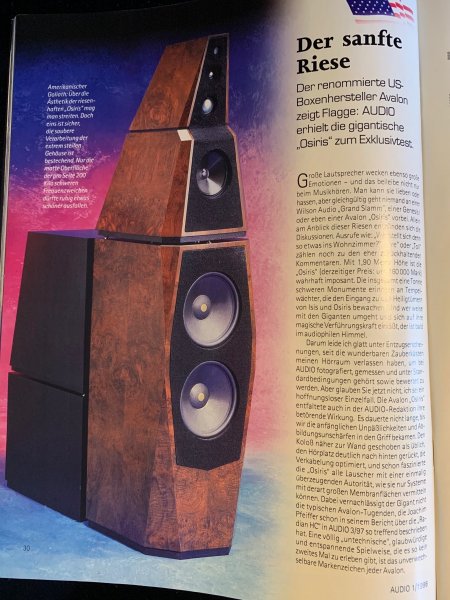
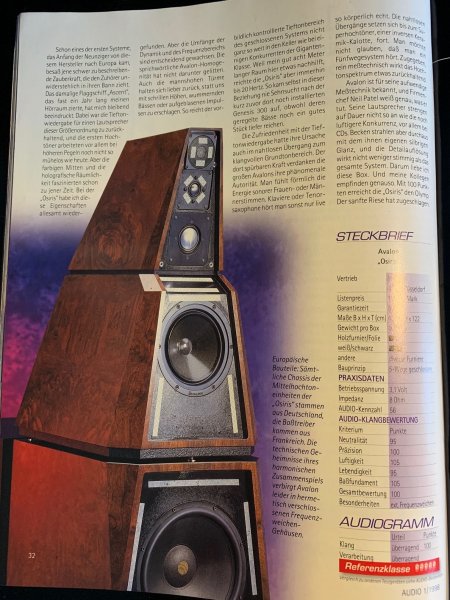
The external crossover already known from the Avalon Ascent was even more complex and is now even split into two separate boxes per speaker
The Crossover has 5 inputs, so it can theoretically be operated with 5 stereo power amplifiers or 10 mono power amplifiers.
The 4 separate elements of the crossover each weigh just over 100kg, which means that this loudspeaker of the reference class at that time gives you around 450kg crossover.
The speakers themselves is optically divided into 3 cabinets and physically divided into 2 cabinets. Neil Patel believes that increasing the band in the ultra high frequency range must result in expanding the band in the subbass range. Unlike his competitor David Wilson, Neil Patel used a very high upper cut-off frequency of 40khz right from the start, whereas Wilson Audio liked to let the speaker run out just above 23khz.
At that time David Wilson and Neil Patel used partially "customized" chassis from the same manufacturer, namely from JM Lab (now well known as Focal), but where David Wilson relied on the capabilities of the inverse JM Lab tweeter dome, Neil Patel constructed an optically separated tweeter cabinet, which is narrow-band relies on three tweeters made of different materials (and manufacturers).
Bass range: Corn type x2 made from a 33cm nomex Kevlar
Midrange: The corn type made from a 23cm nomex Kevlar
Lower treble range: The corn type made from 5cm aluminum magnesium
High range: The dome shape made from 2.5cm titanium
Super tweeters: The reverse dome shape made from 2.5cm ceramics
Anyone who has looked at the "breaking open" of a membrane at different frequencies with a Kippel measuring device, as well as the resonance spectra of the respective materials, understands the theoretical approach of Neil Patel's reference system.
I was allowed to listen to these impressive speakers at the turn of the millennium. I was really impressed by the performance. At that time, I already had listened to several very good systems at home, so I believed that nothing would make me so easily impressed, but the Avalon Osiris managed to do this, even under demo conditions.
But the sheer mass of something between 800 and 1000kg plus the imposing dimensions
Speaker part: Width 430x height 1890x depth of 510mm
Network part: Width 430x height 1150x depth of 600mm
made this speaker disappear in a memory drawer together with my Infinity IRS and Martin Logan Statement etc. experiences,
because it is difficult to set up such a speaker system in a "normal" room.
But if you compare the absolute flagship speakers of the past 20 to 25 years, it is noticeable that products such as Wilson Audio Wamm or Grand Slam as well as Avalon Osiris and Sentinel are rather compact and easy to set up (e.g. no huge dipole or even a 4 tower system). The flagship loudspeakers of the last 5 to 10 years unfortunately have increased their price to market preposition in a way, that the walk of the high-end segment from the performance-oriented to the overpriced luxury product segment in the loudspeaker sector has to take place without me.
However, since the price segment around 100,000 euros was a very exclusive 20 years ago, the correspondingly small quantities produced that time lead to a very limited supply of such loudspeakers "giants". You will see a Wilson Audio Grand Slam from time to time on offer, but speakers like Avalon Osiris, Avalon Sentinel, Wilson Audio Wamm, Martin Logan Statement, Infinity IRS etc. are almost never placed in the used market.
You can imagine, that I am all the more pleased that I have the opportunity to buy an Avalon Acoustics Osiris.
I hope that this time I can get the logistics organized.
(I still remember with pain that I almost bought a Gryphon Poseidon, but it was set up in an attic so that an (affordable) transport could hardly be represented.
As far as I know, the Gryphon Poseidon is still staying (unused) in this attic today)
so I tried to research the history of Avalon Acoustics on the web, should someone has better or more detailed knowledge, I am of course happy about additions and corrections.
Avalon Acoustics speakers have been around since the 1980s and have a varied history. The Avalon Acoustics company was founded by Charles Hansen, who already relied on the work of the development engineer Neil Patel since foundation of the company.
The first speakers presented already had the typical housing design that is still valid today.
This design should not only optimize the sound radiation of the speakers, but also help to disperse the reflections of the bounding room walls.
The first models were given the names "Avatar", "Eclipse" and "Monitor", especially the Eclipse became a commercial success. As the last model of the first portfolio, the top model "Ascent" was presented, which should have been the technology carrier of the Avalon company for many years. The "Ascent" uncompromisingly implemented what Neil Patel had imagined at the time. It didn't make the "Ascent" easier to sell, but it was important to Neil Patel that the crossover in his top model had to be housed in a separate housing.

(The crossover in the separate black housing behind the speakers)
The Avalon Ascent is (in my view) one of the rare offers in the used market,
where you get a very high sonic equivalent to the current market price.
The speakers from Neil Patel and Charles Hansen required a certain level of performance from the connected amplifiers right from the start. The elaborate crossovers simply consumed power, so that the efficiency of the entire portfolio remained below 90db. The impedance curves, on the other hand, were amplifier-friendly, so that Avalon speakers can also be seen with powerful tubes from Audio Research, for example. (in my personal opinion, the bass drivers ever needed some damping factor, so I am not a friend of tubes or Pass / Krell amps on Avalon speakers)
Shortly after the Avalon Ascent appeared, Charles Hansen founded a company for high-end electronics (the Ayre company) and sold the company Avalon Acoustics to Jeff Rowland, who also hired Neil Patel as head of development.
Thanks to Jeff Rowland's contacts, the young company Avalon Acoustics found many new distributors, especially in Asia. Even today, many companies offer Avalon Acoustics speakers and Jeff Rowland amplifiers together.
Unfortunately, the market reacted very negatively to the acquisition of Jeff Rowlands. Previously, many loudspeaker manufacturers had advertised Jeff Rowland's amplifiers as the ideal partner for their own products, but now Jeff Rowland was taken as a competitor and his devices were not longer supported / shown on fairs.
So Jeff Rowland decided to sell Avalon Acoustics to Neil Patel in 1989, who has run the company since then.
Neil Patel carefully renewed the Avalon portfolio and created the probably successful Avalon Acoustics loudspeaker, the Avalon "Eidolon" in the early / mid-nineties.
The program was rounded off by the Avalon "Artus".
The last model offered in 1996 was the one offered until 2005
Avalon Acoustics "Osiris"
presented.
All three models were then marketed by Neil Patel / the Distributors as "The New Avalon"
I found as an example a Japanese brochure :




The Avalon Osiris was offered in Germany in 1996 with a MSRP of 160,000 DM, in 2005 the speaker had risen to about 125,000 EUR. The successor Avalon Sentinel was offered from 2005 at 180,000 euros, currently the Avalon Tesseract presented in 2015 is currently the top model with 350,000 to 400,000 euros in the respective price lists.
Avalon Acoustics was also obviously unable to escape the global price trend in the high-end market
I suspect this will not be the last step
The top models from Wilson Audio (Chronosonic) and Magico (M9) already reach the 750,000 euro threshold, so some headroom for the next Avalon Acoustics Top Model.
If you take a closer look at the Avalon Osiris, you can see the consistent implementation of Neil Patel's claims.


The external crossover already known from the Avalon Ascent was even more complex and is now even split into two separate boxes per speaker
The Crossover has 5 inputs, so it can theoretically be operated with 5 stereo power amplifiers or 10 mono power amplifiers.
The 4 separate elements of the crossover each weigh just over 100kg, which means that this loudspeaker of the reference class at that time gives you around 450kg crossover.
The speakers themselves is optically divided into 3 cabinets and physically divided into 2 cabinets. Neil Patel believes that increasing the band in the ultra high frequency range must result in expanding the band in the subbass range. Unlike his competitor David Wilson, Neil Patel used a very high upper cut-off frequency of 40khz right from the start, whereas Wilson Audio liked to let the speaker run out just above 23khz.
At that time David Wilson and Neil Patel used partially "customized" chassis from the same manufacturer, namely from JM Lab (now well known as Focal), but where David Wilson relied on the capabilities of the inverse JM Lab tweeter dome, Neil Patel constructed an optically separated tweeter cabinet, which is narrow-band relies on three tweeters made of different materials (and manufacturers).
Bass range: Corn type x2 made from a 33cm nomex Kevlar
Midrange: The corn type made from a 23cm nomex Kevlar
Lower treble range: The corn type made from 5cm aluminum magnesium
High range: The dome shape made from 2.5cm titanium
Super tweeters: The reverse dome shape made from 2.5cm ceramics
Anyone who has looked at the "breaking open" of a membrane at different frequencies with a Kippel measuring device, as well as the resonance spectra of the respective materials, understands the theoretical approach of Neil Patel's reference system.
I was allowed to listen to these impressive speakers at the turn of the millennium. I was really impressed by the performance. At that time, I already had listened to several very good systems at home, so I believed that nothing would make me so easily impressed, but the Avalon Osiris managed to do this, even under demo conditions.
But the sheer mass of something between 800 and 1000kg plus the imposing dimensions
Speaker part: Width 430x height 1890x depth of 510mm
Network part: Width 430x height 1150x depth of 600mm
made this speaker disappear in a memory drawer together with my Infinity IRS and Martin Logan Statement etc. experiences,
because it is difficult to set up such a speaker system in a "normal" room.
But if you compare the absolute flagship speakers of the past 20 to 25 years, it is noticeable that products such as Wilson Audio Wamm or Grand Slam as well as Avalon Osiris and Sentinel are rather compact and easy to set up (e.g. no huge dipole or even a 4 tower system). The flagship loudspeakers of the last 5 to 10 years unfortunately have increased their price to market preposition in a way, that the walk of the high-end segment from the performance-oriented to the overpriced luxury product segment in the loudspeaker sector has to take place without me.
However, since the price segment around 100,000 euros was a very exclusive 20 years ago, the correspondingly small quantities produced that time lead to a very limited supply of such loudspeakers "giants". You will see a Wilson Audio Grand Slam from time to time on offer, but speakers like Avalon Osiris, Avalon Sentinel, Wilson Audio Wamm, Martin Logan Statement, Infinity IRS etc. are almost never placed in the used market.
You can imagine, that I am all the more pleased that I have the opportunity to buy an Avalon Acoustics Osiris.
I hope that this time I can get the logistics organized.
(I still remember with pain that I almost bought a Gryphon Poseidon, but it was set up in an attic so that an (affordable) transport could hardly be represented.
As far as I know, the Gryphon Poseidon is still staying (unused) in this attic today)



